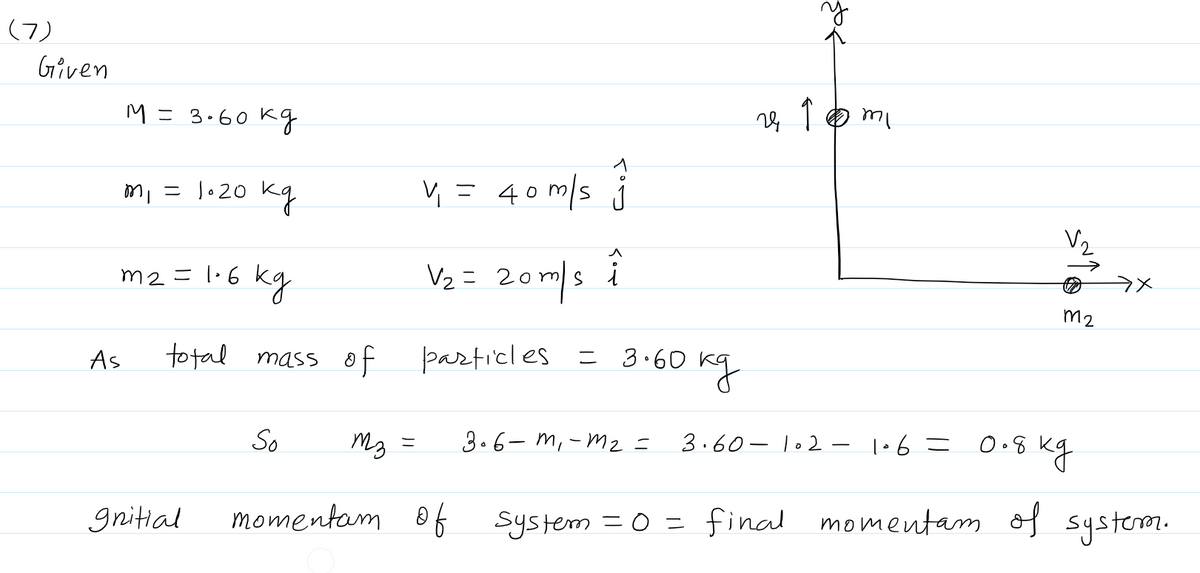7. a. State the Law of Conservation of Mon b. A stationary body of mass 3.60 kg explodes to form three unequal masses which move in three different directions. Two of the masses emerge at right angles, with speeds of 20.0 ms¹ and 40.0 ms¹ as shown in the diagram to the right. 40.0ms¹ m₁ = 1.20 kg i. Calculate the magnitudes of the momentum of each of fragments 1 and 2. 20.0ms¹ m₂ = 1.60 kg ii. Draw a labelled vector diagram relating the momenta of each of the three masses. iii. Use the diagram to calculate the magnitude and direction of the final velocity of the third mass. (Specify the direction relative to the direction of motion of mass 1) iv. Is it possible for any two of the masses in this example to emerge in opposite directions after the explosion? Explain. -IUS / 5. In a region of space where gravity is negligible, the ejection of particles can cause a spacecraft to change direction along a circular arc. The direction at which the particles are emitted at both point A and point B is shown on the diagram below. Direction of ejection at Point A B Direction of ejection at Point B On the diagram above, draw the direction of the force experienced by the spacecraft at Point A due to the ejection of the particles. Justify your answer using one of Newton's Laws.
7. a. State the Law of Conservation of Mon b. A stationary body of mass 3.60 kg explodes to form three unequal masses which move in three different directions. Two of the masses emerge at right angles, with speeds of 20.0 ms¹ and 40.0 ms¹ as shown in the diagram to the right. 40.0ms¹ m₁ = 1.20 kg i. Calculate the magnitudes of the momentum of each of fragments 1 and 2. 20.0ms¹ m₂ = 1.60 kg ii. Draw a labelled vector diagram relating the momenta of each of the three masses. iii. Use the diagram to calculate the magnitude and direction of the final velocity of the third mass. (Specify the direction relative to the direction of motion of mass 1) iv. Is it possible for any two of the masses in this example to emerge in opposite directions after the explosion? Explain. -IUS / 5. In a region of space where gravity is negligible, the ejection of particles can cause a spacecraft to change direction along a circular arc. The direction at which the particles are emitted at both point A and point B is shown on the diagram below. Direction of ejection at Point A B Direction of ejection at Point B On the diagram above, draw the direction of the force experienced by the spacecraft at Point A due to the ejection of the particles. Justify your answer using one of Newton's Laws.
College Physics
11th Edition
ISBN:9781305952300
Author:Raymond A. Serway, Chris Vuille
Publisher:Raymond A. Serway, Chris Vuille
Chapter1: Units, Trigonometry. And Vectors
Section: Chapter Questions
Problem 1CQ: Estimate the order of magnitude of the length, in meters, of each of the following; (a) a mouse, (b)...
Related questions
Topic Video
Question

Transcribed Image Text:7.
a. State the Law of Conservation of Mon
b. A stationary body of mass 3.60 kg explodes to
form three unequal masses which move in three
different directions.
Two of the masses emerge at right angles, with
speeds of 20.0 ms¹ and 40.0 ms¹ as shown in
the diagram to the right.
40.0ms¹
m₁ = 1.20 kg
i. Calculate the magnitudes of the momentum of each of fragments 1 and 2.
20.0ms¹
m₂ = 1.60 kg
ii. Draw a labelled vector diagram relating the momenta of each of the three masses.
iii. Use the diagram to calculate the magnitude and direction of the final velocity of the third
mass. (Specify the direction relative to the direction of motion of mass 1)
iv. Is it possible for any two of the masses in this example to emerge in opposite directions
after the explosion? Explain.
-IUS /

Transcribed Image Text:5. In a region of space where gravity is negligible, the ejection of particles can cause a spacecraft to
change direction along a circular arc. The direction at which the particles are emitted at both point
A and point B is shown on the diagram below.
Direction of ejection at Point A
B
Direction of ejection at Point B
On the diagram above, draw the direction of the force experienced by the spacecraft at Point A
due to the ejection of the particles. Justify your answer using one of Newton's Laws.
Expert Solution
Step 1: Determine the given variables and mass of third fragment.
Step by step
Solved in 4 steps with 7 images

Knowledge Booster
Learn more about
Need a deep-dive on the concept behind this application? Look no further. Learn more about this topic, physics and related others by exploring similar questions and additional content below.Recommended textbooks for you

College Physics
Physics
ISBN:
9781305952300
Author:
Raymond A. Serway, Chris Vuille
Publisher:
Cengage Learning

University Physics (14th Edition)
Physics
ISBN:
9780133969290
Author:
Hugh D. Young, Roger A. Freedman
Publisher:
PEARSON

Introduction To Quantum Mechanics
Physics
ISBN:
9781107189638
Author:
Griffiths, David J., Schroeter, Darrell F.
Publisher:
Cambridge University Press

College Physics
Physics
ISBN:
9781305952300
Author:
Raymond A. Serway, Chris Vuille
Publisher:
Cengage Learning

University Physics (14th Edition)
Physics
ISBN:
9780133969290
Author:
Hugh D. Young, Roger A. Freedman
Publisher:
PEARSON

Introduction To Quantum Mechanics
Physics
ISBN:
9781107189638
Author:
Griffiths, David J., Schroeter, Darrell F.
Publisher:
Cambridge University Press

Physics for Scientists and Engineers
Physics
ISBN:
9781337553278
Author:
Raymond A. Serway, John W. Jewett
Publisher:
Cengage Learning

Lecture- Tutorials for Introductory Astronomy
Physics
ISBN:
9780321820464
Author:
Edward E. Prather, Tim P. Slater, Jeff P. Adams, Gina Brissenden
Publisher:
Addison-Wesley

College Physics: A Strategic Approach (4th Editio…
Physics
ISBN:
9780134609034
Author:
Randall D. Knight (Professor Emeritus), Brian Jones, Stuart Field
Publisher:
PEARSON
